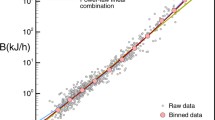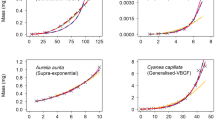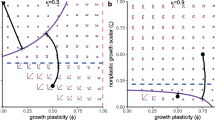Abstract
The growth process of a living organism is studied with the help of a mathematical model where a part of the surplus power is assumed to be used for growth. In the present study, the basic mathematical framework of the growth process is based on a pioneering theory proposed by von Bertalanffy and his work is the main intellectual driving force behind the present analysis. Considering the existence of an optimum size for which the surplus power becomes maximum, it has been found that the scaling exponent for the intake rate must be smaller than the exponent for the metabolic cost. A relationship among the empirical constants in allometric scaling has also been established on the basis of the fact that an organism never ceases to generate surplus energy. The growth process is found to continue forever, although with a decreasing rate. Beyond the optimum point the percentage of shortfall in energy has been calculated and its dependence on scaling exponents has been determined. The dependence of optimum mass on the empirical constants has been shown graphically. The functional dependence of mass variation on time has been obtained by solving a differential equation based on the concept of surplus energy. The dependence of the growth process on scaling exponent and empirical constants has been shown graphically.






Similar content being viewed by others
References
Brody S (1945) Biogenetics and growth. Reinhold Publishing Corporation, New York
Demetrius L (2006) The origin of allometric scaling laws in biology. J Theor Biol 243:455–467
Economos AC (1982) On the origin of biological similarity. J Theor Biol 94:25–60
Harris LA, Duarte CM, Nixon SW (2006) Allometry laws in prediction estuarine and coastal ecology. Estuaries Coasts 29(2):340–344
Hedin LO (2006) Plants on a different scale. Nature 439:399–400
Kim K, Lasker HR (1998) Allometry of resource capture in colonial enidarians and constraints on modular growth. Funct Ecol 12:646–654
Kozolowski J (1992) Optimal allocation of resources to growth and reproduction: implications for age and size at maturity. Trends Ecol Evol 7:15–19
Kozolowski J, Weiner J (1997) Interspecific allometries are byproducts of body size optimization. Am Nat 149:352–380
Makarieva AM, Gorshkov VG, Li B-L (2004) Ontogenetic growth: models and theory. Ecol Model 176:15–26
Mckechine AE, Freckleton RP, Jetz W (2006) Phenotypic plasticity in the scaling of avian basal metabolic rate. Proc R Soc B 273:931–937
Pandian TJ, Vernberg FJ (eds) (1987) Animal energetics. Academic Press, San Diego
Sebens KP (1982) The limit to intermediate growth: an optimal size model applied to passive suspension feeders. Ecology 82:209–222
Sebens KP (2002) Energetic constraints, size gradients, and size limits in benthic marine invertebrates. Integr Comp Biol 42:853–861
Vandermeer J (2006) Metabollic theory of ecology. Trends Ecol Evol 21(3):136–140
von Bertalanffy L (1938) A quantitative theory of organic growth. Hum Biol 10:181–213
Von Bertalanffy L (1957) Quantitative laws in metabolism and growth. Q Rev Biol 32:217–231
West GB, Brown JH, Enquist BJ (1997) A general model for the origin of allometric scaling laws in biology. Science 276:122–126
West GB, Woodruff WH, Brown JH (2002) Allometric scaling of metabolic rate from molecules and mitochondria to cells and mammals. Proc Natl Acad Sci USA 99(1):2473–2478
West GB, Brown JH, Enquist BJ (2004) Growth model based on first principle or phenomenology. Funct Ecol 18:188–196
Author information
Authors and Affiliations
Corresponding author
Rights and permissions
About this article
Cite this article
Biswas, D., Das, S.K. & Roy, S. Importance of scaling exponents and other parameters in growth mechanism: an analytical approach. Theory Biosci. 127, 271–276 (2008). https://doi.org/10.1007/s12064-008-0045-9
Received:
Accepted:
Published:
Issue Date:
DOI: https://doi.org/10.1007/s12064-008-0045-9




